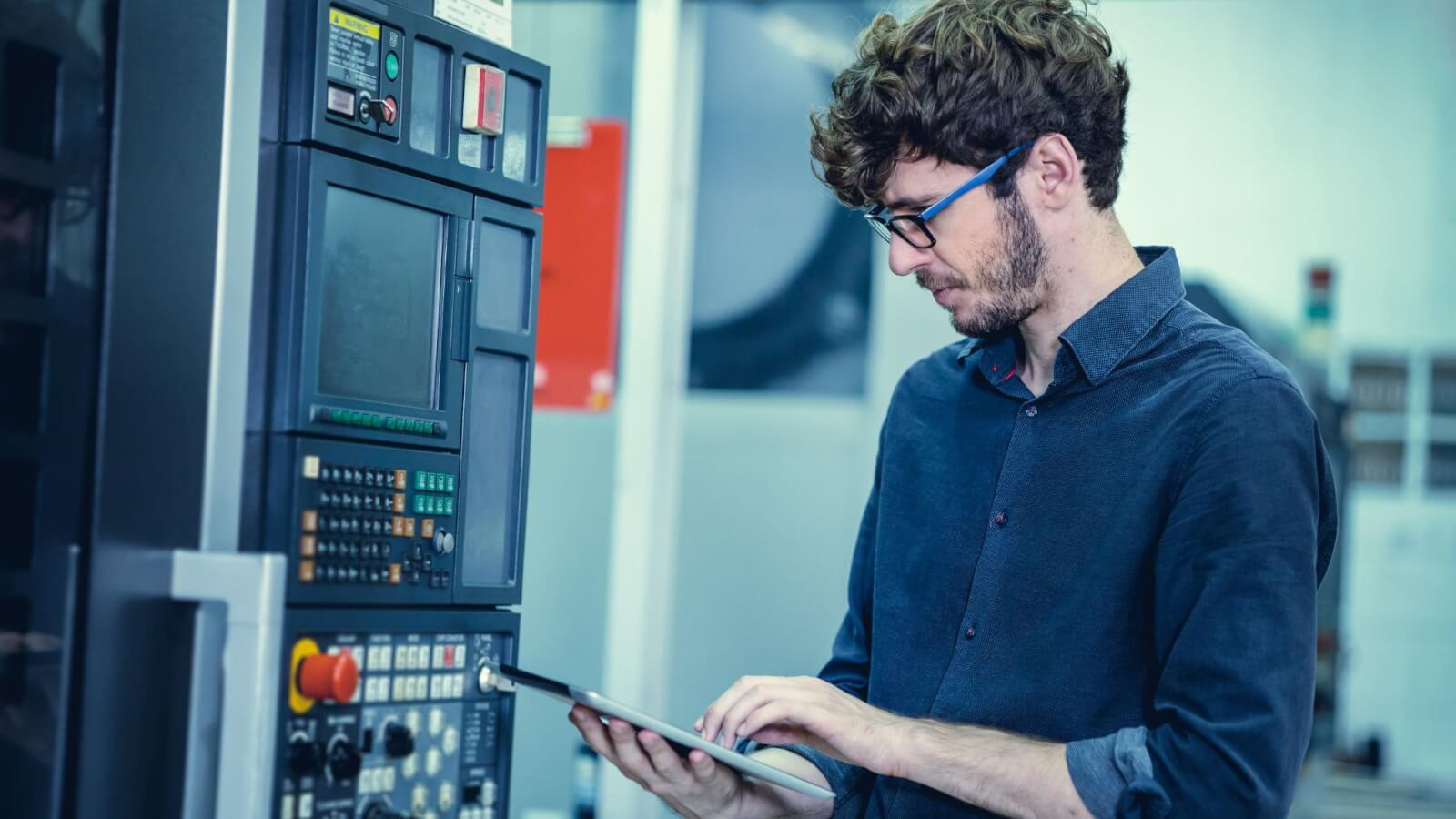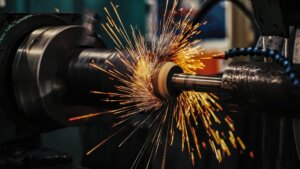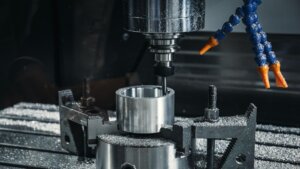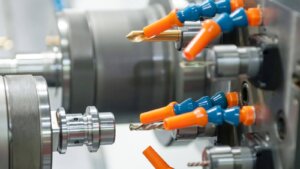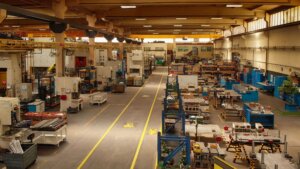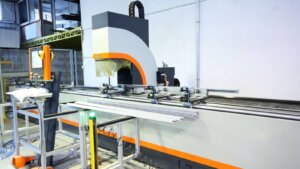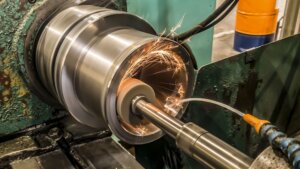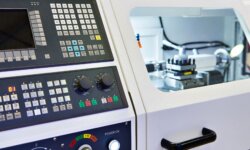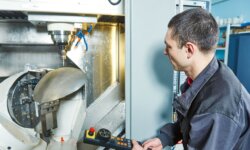In the realm of machining and metalworking, the grinding machine stands as a pivotal tool, central to shaping and refining a multitude of materials. This article delves into the essence of grinding machines, unraveling their history, mechanism, types, and applications in a detailed exploration.
What is a Grinding Machine?
A grinding machine, often known as a grinder, is a machine tool used for grinding. It is a powerhouse of precision and versatility in the manufacturing and metalworking industry.
A grinding machine employs an abrasive wheel as its primary cutting tool for finishing metal and non-metal workpieces. The grinding process is instrumental in achieving high surface quality and dimensional accuracy.
Short History of Grinding Machines
Delving into the history of grinding machines, one discovers a journey of innovation and mechanical advancement.
This journey, stretching back centuries, reveals how grinding machines evolved from simple manual tools to the sophisticated machinery we see today.
Who Invented the Grinding Machine?
The genesis of the modern grinding machine is often credited to a few key figures in history, but the most notable is probably Henry Maudslay, a 19th-century British engineer. His contributions around the early 1800s laid the foundation for subsequent developments in precision grinding.
H3: Grinding Machine History and Developments from Ancient Times to Modern Days The evolution of grinding machines is marked by several key developments:
- Ancient Times: The origins of grinding can be traced back to ancient civilizations where manual grinding stones were used.
- 15th Century: Leonardo da Vinci sketched designs for a basic grinding machine.
- 17th Century: The introduction of the treadle wheel enhanced manual grinding processes.
- 19th Century: The industrial revolution catalyzed significant advancements, including the integration of steam power.
- Early 20th Century: Further enhancements saw the introduction of electric motors, enabling greater efficiency and precision.
- Mid-20th Century: The advent of computer numerical control (CNC) technology marked a turning point, leading to the development of high precision grinding machines.
- Late 20th Century and Beyond: Innovations continued with the introduction of laser-guided and robotic grinding systems, significantly increasing precision and efficiency.
How Does a Grinding Machine Work?
Understanding how a grinding machine operates is crucial for anyone involved in machining or metalworking. Let’s break down the step-by-step process, giving you a clear picture of the intricate workings of a grinding machine.
- Setup: The process begins with setting up the grinding machine. This involves selecting the right grinding wheel based on the material of the workpiece. Factors like wheel diameter, abrasive material, and grit size are critical considerations.
- Securing the Workpiece: The workpiece is then securely mounted on the machine. This could be on a chuck, between centers, or on a rotary table, depending on the type of grinder being used.
- Activating the Machine: Once the setup is complete, the grinding wheel is activated. This wheel, powered typically by an electric motor, rotates at a predetermined speed.
- The Grinding Process: The heart of the operation is the grinding process. The rotating abrasive wheel comes into contact with the workpiece surface, removing material through a combination of crushing and shearing forces. This action can be either a surface grinding or cylindrical grinding, depending on the machine and workpiece configuration.
- Feed Rate and Direction: The workpiece is fed against the grinding wheel at a specific rate and direction. This is controlled either manually or through CNC for precision grinding.
- Coolant Application: Throughout the grinding process, a coolant is applied to minimize heat generation, which can cause thermal damage to both the workpiece and the grinding wheel.
- Finishing: The final stage involves achieving the desired finish and dimensional accuracy. The grinding machine may go through several passes, refining the workpiece to the required specifications.
- Inspection: After grinding, the workpiece is inspected for surface quality, size accuracy, and overall finish.
What are Key Components of a Grinding Machine?
A modern grinding machine is an assembly of multiple critical components, each playing a vital role in its operation. Below is a list of these key components:
- Grinding Wheel: This is the tool that does the actual grinding. It’s made of abrasive grains and bonding material, engineered to cut and shape the workpiece.
- Wheel Head: The wheel head houses the grinding wheel and contains mechanisms for its rotation and positioning.
- Machine Bed: The bed is the framework that supports all parts of the grinder. It is typically robust to absorb vibrations.
- Work Holding Device: This device holds the workpiece in place. It varies based on the machine type, such as a chuck, centers, or a rotary table.
- Table: In surface grinders, the table holds the workpiece and moves it under the grinding wheel.
- Coolant System: This system applies coolant to the grinding area to control heat.
- Control Panel: This includes the controls to operate and adjust the grinding machine, including CNC panels in modern grinders.
- Motor: The electric motor drives the grinding wheel.
- Feed Mechanism: This controls the rate and direction of the workpiece movement.
- Dressing Tool: This tool is used to dress (reshape) the grinding wheel to maintain its sharpness and shape.
What are the Different Types of Grinding Machines?
Grinding machines, each tailored for specific purposes and materials, vary significantly in design and function. They range from small handheld devices to large industrial machines, each type serving a unique role in the world of machining and metalworking.
Belt Grinder
A belt grinder primarily uses a belt coated with abrasive material to finish and shape workpieces. This machine employs a continuous loop of abrasive material (the belt) driven by rollers. The workpiece is brought into contact with the belt to remove material and shape the surface. Common subtypes include stationary grinders and handheld models, each designed for specific applications.
- Main Applications and Uses:
- Shaping and finishing metal and wood.
- Deburring (removing burrs from machined parts).
- Sanding and finishing composite materials.
- Most Useful For: Belt grinders are particularly useful in tasks requiring the removal of substantial amounts of material quickly, such as initial shaping of metal workpieces, or where a smooth finish on wood is desired.
Bench Grinder
Bench grinders, a staple in workshops, are known for their versatility and ease of use. These grinders typically feature two grinding wheels of different grain sizes for roughing and finishing operations. They are mounted on a benchtop and operated manually. Variations include models with different wheel diameters and motor power levels.
- Main Applications and Uses:
- Sharpening cutting tools like drill bits and chisels.
- Smoothing rough edges of metal workpieces.
- Cleaning and polishing metal surfaces.
- Most Useful For: Ideal for small-scale grinding operations, tool sharpening, and minor shaping tasks in workshops and garages.
Cylindrical Grinder
Cylindrical grinders specialize in shaping the external surface of cylindrical workpieces. This type employs a rotating grinding wheel and a rotating workpiece. The workpiece is typically held in place by centers or a chuck. They include plain cylindrical grinders and universal cylindrical grinders, which can handle greater complexity in shape.
- Main Applications and Uses:
- Precision shaping of metal rods and cylindrical parts.
- Producing precise diameters and fine finishes on cylindrical surfaces.
- Most Useful For: They are indispensable in industries requiring high-precision metal parts, such as automotive and aerospace manufacturing.
Surface Grinder
Surface grinders are used to produce a smooth finish on flat surfaces. They consist of an abrasive wheel, a chuck for holding the workpiece, and a reciprocating or rotary table. The surface grinder brings the material into contact with the grinding wheel, which removes material from the workpiece’s surface to create a flat, smooth finish. The two main types are horizontal-spindle and vertical-spindle surface grinders.
- Main Applications and Uses:
- Creating flat surfaces on metal parts.
- Achieving tight tolerances and smooth finishes in tool and die making.
- Grinding flat metal components to specific thicknesses.
- Most Useful For: These machines are crucial in producing high-quality, precise, flat surfaces for tool and die making, as well as for the production of automotive and aerospace components.
Tool and Cutter Grinder
The tool and cutter grinder specializes in the sharpening and shaping of cutting tools like end mills, drills, and other cutting tools. It usually consists of a rotating grinding head and a series of adjustable fixtures to hold and position the workpiece. There are various subtypes, including universal tool and cutter grinders, which offer more flexibility in tool grinding, and specialized forms like drill bit grinders.
- Main Applications and Uses:
- Sharpening milling cutters and tool bits.
- Various grinding tasks in tool manufacturing.
- Re-sharpening and reconditioning of cutting tools.
- Most Useful For: This machine is most useful for precision grinding of cutting tools in tool-making and metalworking shops, ensuring tools maintain their cutting efficiency and accuracy.
Flexible Grinder
A flexible grinder, as the name suggests, offers versatility and ease of use, especially in hard-to-reach areas. It often features a flexible shaft and can be fitted with various grinding tools. Include bench-mounted and portable models, each designed for specific scenarios.
- Main Applications and Uses:
- Grinding in tight or awkward spaces.
- Polishing and finishing tasks.
- Light deburring and grinding tasks on various materials.
- Most Useful For: Flexible grinders are ideal for intricate grinding tasks where precision and accessibility are key, such as in mold making or jewelry manufacturing.
Jig Grinder
A jig grinder is a precision machine used for grinding complex shapes and holes where the highest degrees of accuracy and finish are required. It often employs a high-speed air spindle to rotate the grinding bit. It may include CNC versions for precise control over grinding operations.
- Main Applications and Uses:
- Precision grinding of holes and shapes.
- Finishing holes for dies and molds.
- Complex geometries in precision machining.
- Most Useful For: Jig grinders are critical in applications demanding extreme accuracy and fine finishes, like in the aerospace and die-making industries.
Gear Grinder
Gear grinders are used for the precise machining of gears, employing methods like profile grinding and generating grinding. Include form grinders and generating grinders, each used for different types of gear grinding.
- Main Applications and Uses:
- Precision grinding of gear teeth.
- Finishing operations for high-precision gears.
- Producing high-quality gears for automotive and aerospace applications.
- Most Useful For: These machines are essential in the manufacturing of precise and high-quality gears, particularly in automotive and aerospace engineering where gear performance is critical.
Bore Grinder
A bore grinder is designed specifically for the internal grinding of cylindrical workpieces. It operates with a spindle that rotates the grinding wheel inside the bore or the internal diameter of the workpiece, allowing for precision grinding. Includes CNC bore grinders for high precision and programmable operations, and universal bore grinders that can accommodate a variety of bore sizes.
- Main Applications and Uses:
- Precision internal grinding of bearings and bushings.
- Finishing internal surfaces of cylinders and gears.
- Achieving tight tolerances in bore diameters.
- Most Useful For: Bore grinders are most useful in automotive and aerospace manufacturing where precision internal grinding is crucial for the fit and function of components.
Centre Grinder
Centre grinders are specialized machines used to grind the center points of cylindrical workpieces, ensuring the workpiece can be held accurately in other grinding or machining operations. May include dedicated center grinders and multi-functional machines capable of handling various types of center grinding.
- Main Applications and Uses:
- Grinding centers of shafts and rods for precise alignment.
- Preparing workpieces for further precision machining.
- Ensuring the geometric accuracy of cylindrical parts.
- Most Useful For: This machine is particularly vital in precision engineering fields where the alignment and center accuracy of cylindrical parts are paramount.
Die Grinder
Die grinders are handheld, high-speed rotary tools used for grinding, sanding, or honing materials. They are versatile and can be fitted with a variety of grinding bits. Includes pneumatic die grinders, commonly used in workshops, and electric die grinders for more controlled operations.
- Main Applications and Uses:
- Grinding and finishing metal molds and dies.
- Smoothing edges and surfaces in metalworking.
- Detail work in woodworking and metal crafts.
- Most Useful For: These grinders are essential in workshops and metal fabrication, where detailed grinding work is required on a variety of materials.
Angle Grinder
Angle grinders are versatile handheld tools that use a perpendicular grinding disc to cut, grind, or polish a wide range of materials. Includes corded and cordless models, variable speed angle grinders, and those designed for specific materials like metal or concrete.
- Main Applications and Uses:
- Cutting and grinding metal, stone, and concrete.
- Removing rust and paint from surfaces.
- Polishing and finishing materials in construction and metalworking.
- Most Useful For: Angle grinders are indispensable in construction, metalworking, and emergency rescue operations, offering versatility and power for a wide range of tasks.
Hand Grinder
Hand grinders are portable, manually-operated tools that are used for grinding and polishing. Equipped with a rotating abrasive wheel, these grinders are operated by hand, giving the operator direct control over the tool. They include straight grinders, angle grinders, and die grinders, each designed for specific applications and materials.
- Main Applications and Uses:
- Sharpening tools and blades.
- Smoothing rough edges and surfaces.
- Light-duty grinding and polishing tasks.
- Most Useful For: Hand grinders are particularly useful for small-scale, precision tasks in workshops, construction sites, and DIY projects, offering versatility and convenience.
Pedestal Grinder
Pedestal grinders are larger grinding machines mounted on a pedestal or a stand. These stationary machines typically feature two grinding wheels of different grit sizes for roughing and finishing operations. Include industrial-grade pedestal grinders and bench grinders, which are a smaller variant often used in workshops.
- Main Applications and Uses:
- Grinding and shaping metal tools and components.
- Deburring and polishing metal parts.
- Sharpening cutting tools like drills and chisels.
- Most Useful For: These grinders are ideal for heavy-duty grinding tasks in manufacturing, metalworking shops, and industrial settings.
Portable Grinder
Portable grinders are compact, power-driven grinding tools designed for mobility and flexibility. They typically feature a rotating abrasive wheel, and are powered either electrically or pneumatically. There are various subtypes including angle grinders, straight grinders, and vertical grinders, each suited for different tasks.
- Main Applications and Uses:
- On-site material cutting and grinding.
- Surface preparation and finishing.
- Welding preparation and metalwork in construction.
- Most Useful For: These grinders are essential for construction sites, field repairs, and any situation where mobility and on-the-spot grinding are required.
Precision Grinder
Precision grinders are used for applications requiring high accuracy and fine surface finishes. They are equipped with fine-grit grinding wheels and have advanced mechanisms for precise control. Includes cylindrical precision grinders, surface precision grinders, and internal precision grinders, each designed for specific precision grinding tasks.
- Main Applications and Uses:
- Achieving high surface quality and precise dimensions on metal parts.
- Grinding of tools and dies for tool making.
- Precision grinding in aerospace and automotive components.
- Most Useful For: Precision grinders are indispensable in industries where fine tolerances and surface finishes are critical, such as aerospace, tool and die making, and automotive manufacturing.
Plunge Cut Grinder
A plunge cut grinder, designed for precision, performs grinding by plunging the rotating wheel into the workpiece without lateral movement. It’s a form of cylindrical grinding. This category includes CNC plunge cut grinders for high precision and programmable operations.
- Main Applications and Uses:
- Grinding specific sections of cylindrical parts.
- Creating slots and grooves in metal parts.
- Finishing operations in complex manufacturing processes.
- Most Useful For: Ideal for tasks requiring precision and depth control, especially in automotive and aerospace component manufacturing.
Form Grinder
Form grinders specialize in grinding complex shapes and surfaces by using formed grinding wheels that match the shape of the workpiece. They include both manual and CNC form grinders, catering to varying levels of complexity.
- Main Applications and Uses:
- Creating intricate shapes and patterns on metal parts.
- Precision grinding of molds and dies.
- Detailed finishing work in tool manufacturing.
- Most Useful For: Form grinders are most useful for tool and die making, as well as precision part manufacturing where intricate shapes and high accuracy are required.
Internal Grinder
Internal grinders are designed for grinding the internal diameters of cylindrical workpieces, ensuring a smooth and accurate internal surface. Different types include CNC internal grinders for complex and precise operations, and universal internal grinders for a range of sizes.
- Main Applications and Uses:
- Grinding the internal surfaces of gears, bearings, and other parts.
- Ensuring precise internal diameters and surface finishes.
- High-precision manufacturing in automotive and aerospace industries.
- Most Useful For: These machines are crucial for internal grinding applications in industries where precision and internal surface quality are paramount.
Centreless Grinder
Centreless grinders perform grinding without using centers to hold the workpiece. The workpiece is placed between a grinding wheel, a regulating wheel, and a work blade, allowing for efficient and precise grinding. 2 main subtypes Include through-feed and in-feed centerless grinders, each suitable for different types of workpieces.
- Main Applications and Uses:
- High-volume production grinding of cylindrical parts.
- Achieving tight tolerances in roundness and diameter.
- Grinding long, slender parts that could deform if held between centers.
- Most Useful For: Centerless grinding is essential in mass production settings, particularly in the manufacturing of automotive components and precision parts.
Universal Grinder
Universal grinders are versatile machines that can perform a variety of grinding tasks thanks to their interchangeable grinding heads and attachments. They are capable of handling cylindrical, surface, and even complex shapes. This category includes manual universal grinders and CNC (Computer Numerical Control) universal grinders, each suited to different levels of precision and automation.
- Main Applications and Uses:
- General-purpose grinding of various tools and parts.
- Precision shaping of metal components.
- Flexible grinding operations in toolrooms and workshops.
- Most Useful For: Universal grinders are ideal for toolrooms and manufacturing settings where a wide range of grinding tasks are performed, and versatility is key.
What is the most used type of grinding machine?
The most commonly used type of grinding machine is the surface grinder. Widely used in manufacturing and tool making, surface grinders excel at creating flat surfaces and precise angular relationships. Their versatility and reliability make them indispensable in industrial settings.
What Is the Most Expensive Type of Grinding Machine?
The most expensive type of grinding machine is typically a CNC (Computer Numerical Control) grinding machine. These advanced machines offer unparalleled precision and control, integrating sophisticated software and automatic tool changers, making them essential for complex and high-precision tasks.
What Is the Cheapest Type of Grinding Machine?
The cheapest type of grinding machines are usually the manual bench grinders. These are basic tools ideal for small-scale grinding and sharpening tasks. Their simplicity and ease of use make them affordable for both professionals and hobbyists.
How Are Grinding Machines Used in Various Industries?
Grinding machines are versatile tools essential in various industrial sectors. Their applications span from removing excess material to achieving precision finishes. Here’s a closer look at their use in different industries:
- Automotive Industry: Used for grinding gears, shafts, and other engine components to exact specifications.
- Aerospace Industry: Employed to achieve precise tolerances and smooth finishes on aircraft components.
- Tool and Die Making: Essential for shaping and sharpening cutting tools, dies, and molds.
- Metalworking: Grinding machines are pivotal in shaping, sharpening, and finishing different metal parts.
- Medical Equipment Manufacturing: Used for creating precise and smooth surfaces on surgical instruments.
- Woodworking: Employed in shaping and finishing wood products and sharpening woodcutting tools.
- Construction: Used for grinding concrete surfaces and cutting concrete reinforcements.
- Railway Industry: Essential for maintaining and repairing rail tracks and components.
- Electronics Manufacturing: Grinding machines help in finishing electronic components, ensuring precise dimensions.
- Plastic Manufacturing: Utilized in shaping and finishing plastic components and molds.
- Ceramics Industry: Used for precision grinding of ceramic parts and components.
- Jewelry Making: Employed in shaping, polishing, and finishing intricate jewelry pieces.
What Materials Can Be Cut Using Grinding Machines?
Grinding machines, known for their versatility and precision, are capable of working with a variety of materials. Each material requires specific techniques and considerations for effective grinding.
Metal
Metal is the most common material worked on grinding machines. These machines excel in shaping, sharpening, and finishing metal parts due to their hard, abrasive wheels.
- Applications and Uses:
- Sharpening cutting tools like drills and milling cutters.
- Smoothing welds and rough metal surfaces.
- Shaping metal parts in tool and die making.
- Ideal for Projects Involving: Precision metalworking, automotive part manufacturing, and fabrication workshops where metal is the primary material.
Concrete
Grinding machines are also used in construction, particularly for grinding concrete surfaces to smooth or level them.
- Applications and Uses:
- Smoothing rough concrete surfaces.
- Preparing floors for finishes or coatings.
- Removing paint or other coatings from concrete.
- Ideal for Projects Involving: Construction and renovation where concrete surfaces need to be prepared or finished.
Tile
Tiles, both ceramic and stone, can be shaped and finished using specific types of grinding machines.
- Applications and Uses:
- Smoothing edges for installation.
- Shaping tiles for custom fits.
- Creating decorative patterns or finishes on tile surfaces.
- Ideal for Projects Involving: Tile installation, custom tile work, and artistic projects involving ceramics or stone.
Stone
Stone grinding is another area where grinding machines are extensively used, especially in the monument and countertop industries.
- Applications and Uses:
- Shaping and smoothing stone surfaces.
- Creating decorative features on stone.
- Polishing stone countertops and monuments.
- Ideal for Projects Involving: Monument making, countertop fabrication, and custom stone work.
Can You Cut Fiberglass with a Grinder?
Yes, fiberglass can be cut using a grinder, but it requires specific types of grinding wheels designed for this material to prevent fraying and to ensure a smooth cut.
- Considerations:
- Use a grinding wheel suitable for fiberglass to prevent damage.
- Ensure proper safety measures due to fiberglass dust.
- Be aware of the high-speed cutting to avoid overheating the material.
What are the Advantages of Grinding Machines?
Grinding machines, integral to modern machining, offer several benefits:
- High Precision: Allows for achieving tight tolerances and smooth finishes on workpieces.
- Versatility: Capable of grinding a wide range of materials, from metals to composites.
- Efficiency: High-speed operations increase productivity, especially in repetitive tasks.
- Consistency: Ensures uniformity in size and finish across multiple workpieces.
- Customization: Adaptable to various grinding methods and tools for specific applications.
- Surface Quality: Produces superior surface finishes that might be difficult to achieve with other machining processes.
- Complex Shapes: Capable of grinding intricate shapes and features with precision.
- Automation Potential: CNC grinding machines allow for automated, precise, and repeatable operations.
How Much Does a Grinding Machine Cost?
The cost of grinding machines varies widely based on type, capacity, and features. Here’s an overview of average price ranges in USD:
- Manual Bench Grinders: Typically cost between $50 – $500. Ideal for small-scale grinding tasks.
- Surface Grinders: Range from $1,000 to $20,000. Used for precision flat surface grinding.
- Cylindrical Grinders: These can cost between $10,000 and $50,000, depending on size and precision capabilities.
- CNC Grinding Machines: The most advanced and expensive, ranging from $50,000 to over $150,000. Ideal for complex, high-precision work.
What is the Lifespan of a Grinding Machine?
Most grinding machines have an average lifespan of 10 to 20 years. Lifespan can be extended with proper maintenance and timely repairs.
Factors influencing longevity include frequency of use, material types processed, and adherence to maintenance schedules.
How Accurate a Grinding Machine Is?
The accuracy of a grinding machine depends on its type and quality. High-precision machines offer:
- Surface Grinders: Accuracy up to ±0.0001 inches.
- Cylindrical Grinders: Capable of achieving tolerances within ±0.0001 inches.
- CNC Grinders: Offer the highest precision, with tolerances as tight as ±0.00001 inches in some cases.
How Much Power Does a Grinding Machine Require?
Power requirements for different types of grinding machines vary:
- Manual Bench Grinders: Typically require between 250 – 750 watts.
- Surface Grinders: Range from 2,000 to 5,000 watts, depending on size.
- Cylindrical Grinders: Usually need between 5,000 to 10,000 watts.
- CNC Grinding Machines: The most power-intensive, requiring upwards of 10,000 watts for high-precision models.
Keep in mind that this area is strongly subjective, so always research the machine tool you plan to buy.
How Can You Ensure Safety While Operating a Grinding Machine?
Ensuring safety while operating a grinding machine is crucial to prevent accidents and injuries. This equipment, with its high-speed rotating abrasive wheels, can pose several hazards if not handled properly. Here’s how you can maintain safety:
- Safety Gear: Always wear appropriate personal protective equipment (PPE). This includes safety goggles to protect your eyes from flying debris, ear protection to guard against noise, gloves to protect your hands, and a face shield for added safety.
- Machine Inspection: Before use, inspect the grinding machine for any damage or wear, particularly the grinding wheel. Ensure all guards and safety shields are in place and in good condition.
- Proper Training: Only operate a grinding machine if you have received adequate training. Understanding the machine’s functions, controls, and emergency stops is vital.
- Secure Workpieces: Firmly secure the material you’re grinding to prevent it from slipping, which could cause an accident.
- Correct Wheel Selection: Use the appropriate wheel for the material you are grinding. Different materials require different types of abrasive wheels.
- Wheel Speed: Check that the wheel speed (RPM) is compatible with the machine. An incompatible wheel can shatter or cause the machine to malfunction.
- Regular Maintenance: Regularly maintain and service the grinding machine to ensure it operates correctly and safely.
- Avoid Loose Clothing: Wear fitted clothing and keep long hair tied back to prevent entanglement in the rotating parts of the machine.
- Clean Work Area: Keep the area around the grinding machine clean and free of debris, which can be a tripping hazard or interfere with the operation of the machine.
- Fire Safety: Be aware of fire hazards, especially when grinding metals that can create sparks. Keep a fire extinguisher nearby and ensure there are no flammable materials in the vicinity.
What Are the Essential Maintenance Practices for a Grinding Machine?
Proper maintenance is key to the longevity and performance of grinding machines. Regular and systematic maintenance ensures they operate efficiently and safely. Here’s a list of essential maintenance practices:
- Regular Checks: Perform routine inspections to identify any signs of wear or damage, especially to the grinding wheel and other moving parts.
- Cleaning: Keep the machine clean. Remove grinding dust and debris that can accumulate and affect the machine’s performance.
- Lubrication: Regularly lubricate moving parts to reduce friction and prevent wear. Use the recommended lubricant for your specific grinding machine.
- Wheel Inspection and Dressing: Regularly inspect grinding wheels for cracks and wear. Use a wheel dresser to maintain the correct wheel shape and sharpness.
- Tightening and Adjustments: Check and tighten any loose bolts and nuts. Adjust the guides and guards as necessary for precise operation.
- Electrical Checks: Regularly inspect the electrical components, including wires and connections, for any signs of damage or wear.
- Coolant System Maintenance: If your grinder uses a coolant, ensure the system is clean and free of blockages, and the coolant is at the right level.
- Spindle and Bearing Checks: Check the spindle and bearings for any play or unusual noises which might indicate wear.
- Replacement of Worn Parts: Replace any worn or damaged parts immediately to prevent further damage and ensure safety.
- Record Keeping: Keep a maintenance log to track inspections, repairs, and replacements. This helps in understanding the machine’s wear patterns and planning future maintenance.
Following these maintenance practices will not only prolong the life of your grinding machine but also ensure it operates at its best, producing quality results.
What Are the Common Problems and Solutions in Grinding Machine Operations?
Even with meticulous maintenance, grinding machines can encounter issues. Here’s a list of common problems and their solutions:
- Wheel Wearing Out Quickly: This might be due to incorrect wheel type or feed rates. Solution: Use the correct wheel and adjust feed rates.
- Poor Surface Finish: Causes could be a worn-out wheel, incorrect wheel speed, or improper dressing of the wheel. Solution: Redress the wheel, check the speed, and replace the wheel if necessary.
- Machine Vibration: Loose parts, imbalance in the grinding wheel, or a faulty drive belt can cause vibration. Solution: Tighten loose parts, balance the wheel, and check the drive belt.
- Overheating of Workpiece: This can be due to excessive grinding pressure or a too-hard wheel. Solution: Use a softer wheel and adjust the grinding pressure.
- Chatter Marks: These are often caused by an out-of-balance wheel or a worn spindle. Solution: Balance the wheel and inspect the spindle for wear.
- Wheel Glazing: This occurs when the wheel becomes too smooth due to a hard or fine grain. Solution: Redress the wheel to expose new abrasives.
- Inaccurate Grinding: Can be due to a misaligned machine or a worn-out spindle. Solution: Check and adjust machine alignment and inspect the spindle.
- Electrical Problems: Issues like erratic machine behavior can be due to electrical faults. Solution: Inspect electrical connections and components for faults.
- Coolant Issues: A blocked nozzle or a low coolant level can cause problems. Solution: Clean the nozzle and ensure the coolant level is adequate.
- Noise during Operation: This can be due to worn bearings or loose components. Solution: Replace bearings and tighten any loose components.
What are the Factors to Consider When Choosing a Grinding Machine?
Selecting the right grinding machine for your needs is crucial for achieving desired results. Here are key factors to consider, each with insights and tips to guide your choice:
- Type of Grinding Machine: There are various types, including surface grinders, cylindrical grinders, and tool and cutter grinders. Understand your requirements to select the appropriate type.
- Material of the Workpiece: Different materials require different grinding wheels and machine types. For example, harder materials might need a more robust machine with a suitable abrasive wheel.
- Size and Shape of the Workpiece: Consider the physical dimensions and shape. Larger or irregularly shaped workpieces might require a machine with greater flexibility and a larger bed.
- Precision Required: High precision grinding machines are essential for tasks requiring tight tolerances. Consider machines with CNC capabilities for complex shapes and high accuracy.
- Grinding Wheel Specifications: The wheel’s material, grain size, bonding agent, and diameter impact the grinding process. Ensure compatibility with your workpiece material and desired finish.
- Power and Speed: Check the machine’s motor power and wheel speed. Higher power and speed allow for quicker material removal but might not be suitable for all materials.
- Coolant System: Grinding generates heat, which can affect the workpiece. Machines with efficient coolant systems can help maintain surface quality and prevent thermal damage.
- Ease of Operation and Control: Consider the user interface, especially for CNC grinders. User-friendly controls and programmable features can significantly increase efficiency.
- Safety Features: Safety is paramount. Look for machines with adequate safety features like wheel guards, emergency stops, and lockout mechanisms.
- Cost and Budget: Grinding machines vary in price. Set a budget but consider long-term cost-effectiveness, including maintenance and operational costs.
- Manufacturer and Support: Choose a reputable manufacturer. Good after-sales support, availability of spare parts, and technical assistance are important for ongoing operation.
Conclusion
Selecting the right grinding machine is a critical decision that impacts the quality, efficiency, and safety of your grinding operations. By considering the factors outlined, such as the type of machine, material to be ground, required precision, wheel specifications, and safety features, you can make an informed decision that best suits your needs.
Remember, the right machine not only enhances productivity but also contributes to the longevity of the equipment and the safety of the operators.
Consider these aspects thoroughly to ensure a wise investment in your grinding operations.
